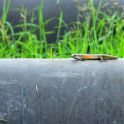
AeroCoV - Predicting infection routes of SARS-CoV-2 aerosols in indoor environments
In order to obtain reliable and meaningful results, the researchers simulated two real scenarios within the software: After having entered the main characteristics of SARS-CoV-2 as well as human respiratory activities and aerosol release processes into COCOSYS, they calculated a case study from research literature in a first step: The comparison of the results shows that the time course of the infection risk in an Italian pharmacy can be reproduced well under different conditions (before and after the lockdown).
In a next step, the potential infection risk was calculated in a comprehensive use case in a room of a hospital and care facility. For this purpose, the room was virtually modelled in COCOSYS. The research team assumed that an infected person lives in the room and that work processes take place that are typical for a care facility.
Using COCOSYS to determine the risk of infection
In particular, the scientists were able to investigate the interaction of several factors – such as respiratory activity, concentration of virus-containing aerosols in the room air, room-related boundary conditions, varying temperature and humidity in the room, influence of air exchange and filter systems (masks) – in detail and over an adequate period of time. This clearly distinguishes the COCOSYS approach from simplified analytical approaches and computational fluid dynamics (CFD) calculations, on the basis of which it is hardly possible to derive scientifically justified recommendations for action in the context of aerosol dispersion within complex room geometries. Building on the AeroCoV project, subsequent work can be carried out to investigate scenarios with several rooms and more complex interactions between people (including various activities).
For the investigation of aerosol dispersion in indoor air, there are no restrictions with regard to the type of virus considered. The approach chosen here thus offers the possibility of transferring the knowledge gained to forthcoming dispersion pathways of infectious aerosols or mutations of the SARS Cov-2 virus and optimising actions and hygiene measures for the future.
Based on the results of the research report, a GRS developer team has also developed a new app: With “Aerosol Control”, users can determine their risk of infection with SARS-CoV-2 in a room. By entering various influencing factors (number of people in the room, length of stay, ventilation, etc.), the risk of infection can be calculated for different scenarios: a two-hour flight with 40 people, a 30-minute train journey with 10 mask-wearing fellow passengers in the compartment, or a three-hour meeting with a friend. The app will soon be available free of charge for iOS and Android.
Project highlights Environment and Energy

According to the Federal Network Agency, renewable energies in Germany now cover around 31 percent of electricity consumption. Many of the renewable energies feed electricity into the grid depending on wind and weather. When times of high feed-in coincide with low power consumption, there is an oversupply. Since the power grids currently cannot accommodate this oversupply, wind and solar power plants have to be shut down from time to time.